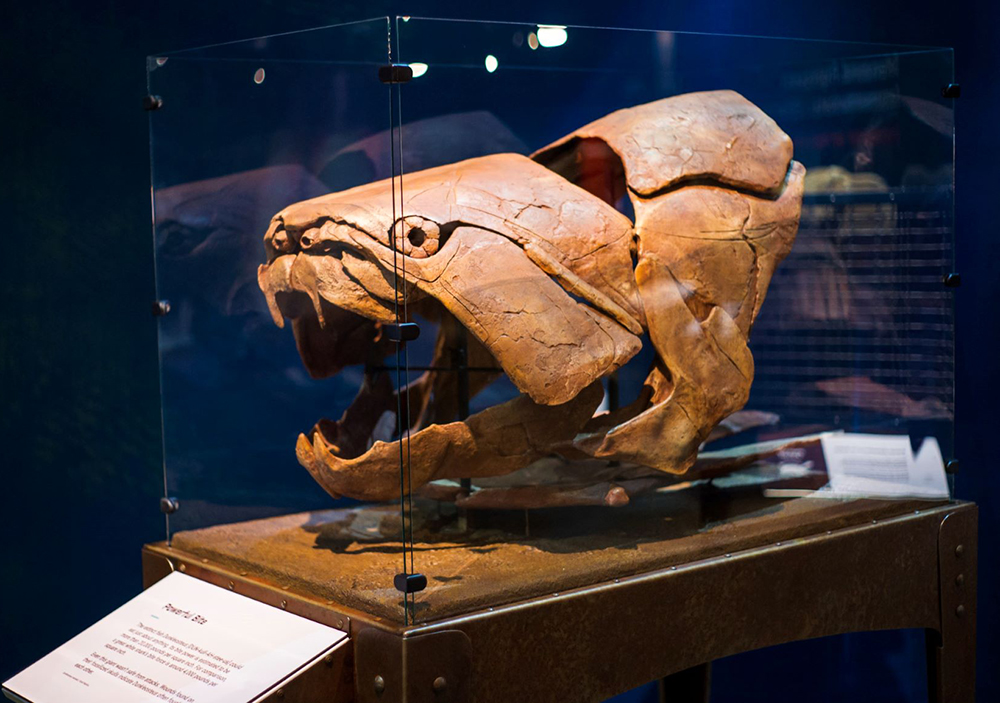Explore Exhibits
Visit our Gallery Guide page or Download Gallery Map.
Visit our Gallery Guide page or Download Gallery Map.
They're here now, but they won’t be here forever. You won’t want to miss these great temporary exhibitions. Be sure to visit the museum soon and see them before it's gone!
Be sure to check back to this web page to keep up to date on what’s at the Sternberg Museum.

MAY 24th!
Sternberg Museum will be happy to host Animal Armor by Gaston Desgins
The exhibit Animal Armor brings together a fascinating, eclectic mix of creatures all bound by their similar use of armor. The exhibit offers an exciting tour through the last 500 million years of armor evolution. The rise of armor in the animal kingdom is illustrated by dozens of pieces, including fantastic casts from recent dinosaur discoveries, giant insect sculptures, and bizarre ice age mammals. From primitive ocean dwellers to armor adaptation by ancient humans, Animal Armor brings the evolutionary story of armor full circle.
The Sternberg Museum of Natural History currently houses about 3 million specimens in total; representing the disciplines of paleontology, paleobotany, geology, botany, entomology, ichthyology, herpetology, ornithology, and mammalogy.
In our permanent exhibits, you will have an opportunity to view some of our specimens from our collections, including our popular specimen Fish-within-a-fish. Our five permanent exhibits are, The Fossil Gallery, Bringing Fossils to Life, Rattlerssss: From Fear to Fascination, The Ice Age Hall, and the Earth Science Hall.
The Fossil Gallery
The Fossil Gallery not only holds our popular Fish-within-a-fish specimen, but it also holds both of Kansas' state fossils, the Tylosaurus and Pteranodon. A majority of the fossils are in Kansas, giving you an idea of what kind of environment the Great Plains looked like 65 million years ago.
Bringing Fossils to Life
Bringing Fossils to Life shows you the transformations that life has undertaken throughout time. With modern animals and their ancient relatives for comparisons, see the progression of evolution, and the motivations behind these changes.
Rattlerssss: From Fear to Fascination
The Sternberg Museum has created a one-of-a-kind educational exhibit on the rattlesnakes of the United States. Over 40 species of rattlesnakes are alive on the earth today, and over 20 of them occur somewhere in the United States.
This exhibit centers on the display of LIVE rattlesnakes, ranging from the gigantic Eastern Diamondback to the extremely toxic Tiger Rattlesnake. Come learn about where these snakes occur, the habitats they live in, and the unique behaviors and adaptations of each species. Check-in frequently, as the individual snakes in the display are regularly changed to show variations in color and pattern.
The Ice Age Hall
The Ice Age Hall displays prehistoric mammals as well as some modern mammals. During the Pleistocene Epoch, the Earth’s climate was undertaking some major changes. With dropping temperatures and more water turning into ice, the flora and fauna had to adjust to the new environment.
Exploring Earth Science Hall
The Exploring Earth Science Hall summarizes the work and purpose of geosciences, showcasing some findings by the Sternberg family. It also displays our rocks, minerals, and meteorites.
The Diorama
Take a step back 65 million years ago and see Kansas and Colorado during the Late Cretaceous Epoch. Dive into the Western Interior Seaway and “swim” with Xiphactinus and Tylosaurus. Hop on land and walk among the dinosaurs and animals that inhabited the shorelines of the seaway.